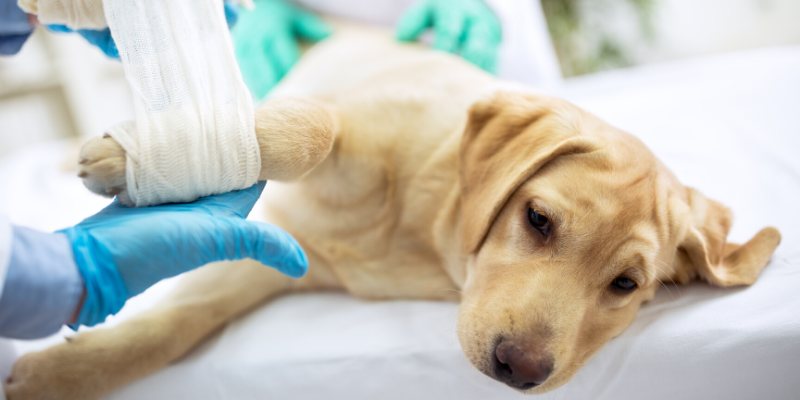
If your pet as been sent home with a bandage on, it’s important that as an owner, you know how to properly manage their bandage so that their wound heals quickly.
- Do- check the bandage regularly
- Do- ensure that it stays clean and dry
- Do- call us for advice if it gets wet or comes off
- Do- call us for advice if your pet starts limping or you think the bandage may be too tight or too loose. If they have suddenly become bothered by the bandage it may be a sign of discomfort or an infection
- Don’t- let your pet lick or chew at the bandage
- Don’t- try to re-dress it yourself
- Don’t- put any cream or ointment on the wound unless it has been recommended by the vet
- Don’t- let them go outside if the grass is wet without adequate protection
- Don’t- give them a bath
Keeping it dry:
We can give you a plastic modified drip bag to put over the bandage when your dog goes outside. Avoid leaving this on for too long as it is not breathable. A thick plastic bag like a freezer bag will also be suitable. Keep outdoor cats indoors whilst they have a bandage on, you will need to get a litter tray for them to use during this time if you do not have one already.
Preventing them chewing/licking:
For the first few days you may be advised to use a plastic ‘Elizabethan’ collar on your pet. There are alternatives which we can show you, for example soft collars, or inflatable collars but, especially for paw or tail bandages, the plastic collar is usually still the best option as your pet should not be able to get their nose around it. For persistent chewers, it may be necessary to have this on the entire time the bandage is in place.
The collar should be on tight enough that it won’t come off but you should still be able to fit two fingers between the collar and the neck. For pets with superpowers when it comes to removing the collar, you could try attaching the plastic collar to their own collar which may be more secure.
Pets should be able to eat and drink despite wearing the collar but if necessary, you can remove it at dinnertime and replace it after they have eaten, making sure to watch them at all times while the collar is off.
A child’s sock can also act as a deterrent for a bandage on the paw – you may need to tape this on using a pet-suitable tape.
You could also try a repellent spray- for example bitter apple spray that gives the bandage a nasty taste and prevents them licking at it. Don’t soak the bandage in it, just a light spray should do the trick.
Remember that it’s not just the pet that has had the surgery or injury that you need to keep away from licking the bandage – make sure their companion pets are not doing it for them!
Tail bandages are particularly tricky, especially with a waggy-tailed dog! Try to keep them in more open spaces with fewer objects to hit their wagging tail on, and provide them with plenty of distraction with toys etc.
Distraction ideas:
You have been advised to limit exercise so your pet is likely to get bored! Here are some ideas to keep them busy and distracted:
- Kongs or other refillable chew options- these are great for most pets! They can be filled with almost anything (check out the Kong website for suggestions). They can also be filled and then frozen making them last even longer! Make sure you chose one that is an appropriate size for your pet.
- Snuffle mats- these can be homemade or bought and can keep a pet entertained for ages!
- Treat balls- you can use a portion of their usual dry food. These encourage gentle exercise and should make dinner time last a little longer!
Just bear in mind the level of exercise restriction that has been advised and whether the above would be suitable for them. Do not encourage them to participate in an activity that may compromise the injury or surgery they are recovering from.
Note: Remember to account any extra calories from training or interactive feeding methods in their daily intake (especially as they are not getting as much exercise!).
Call us on 01435 864422 if you have any questions about managing your pet’s wound.

